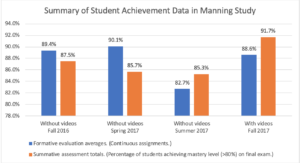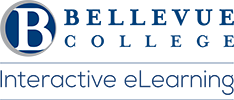by Brian Bergen-Aurand
Since the 1980s, we have seen plenty of research on the isolating effects of digital education. Students taking online courses often complain of feeling lonely and detached from their instructors and peers and disengaged from the course content because of the lack of social interaction involved in many elearning environments.
For the past several decades, we have also seen a good deal of research expounding strategies designed to reduce the “transactional distance” and increase the sociality as well as the sense of community in digital classrooms. One such technique discussed in much of the literature is the use of opening exercises, especially welcoming videos and non-content-related discussion boards. Many studies recommend educators employ these types of activities to invite students into their courses, familiarize them with basic interactive practices, and expose them to course expectations, or “netiquette,” without much academic risk.
Most research on digital learning and training asserts that instructors should include personal videos (with a light-hearted, perhaps humorous tone) in their online classes. It especially recommends incorporating personal introductions at the start. Furthermore, some scholarship suggests incorporating such videos—about relatable moments in instructors’ lives, popular culture, school life, and local events pertaining to the discipline, for example—at regular intervals throughout the course. The claim has been that such videos and attendant activities improve student engagement and reduce participant isolation.
However, in his doctoral dissertation—Using Videos as Relationship Builders in a Digital Learning Environment (Kansas University, 2018)—Jeffrey Manning challenges the efficacy of such “relationship” videos and discussions boards in cultivating student-instructor and peer-to-peer rapport or facilitating student achievement by increasing perceptions of “social presence.”
Manning’s research led to four findings regarding the effects of “relationship” activities in digital learning:
- First, overall, students reported that they enjoyed such activities, especially when they were asked to engage in no-risk, non-content-related discussions at the start of classes. They found these tasks to be a good introduction to interacting with the LMS and other participants. They liked reading and replying to one another’s posts.
- Second, students reported that they found instructors who employ such activities more approachable and see them more as “real people.” They also said they appreciated having instructor-created content in the course. However, they also stated that instructors who included “welcoming” videos and other “relationship” materials were no more present than in other courses.
- Third, students further reported that “relationship” videos and activities did not change their perception of the presence and engagement of other students in the course. While students felt such videos and exercises would increase their ability to participate in the course, and they felt “significantly” higher levels of trust and open communication, they reported that they did not perceive a “significant” change in the group identity or dynamics after the videos compared to before the videos. They did not feel other students were more engaged.
- Fourth, and finally, “welcoming” videos and “relationship” activities appear to have no impact on student achievement. In fact, in this one study involving such activities, students did less well on formative evaluations and only did as well as usual on the summative assessment (see chart). According to Manning, after engaging in welcoming exercises and screening “relationship” videos, students did less well on regular assignments throughout the semester. A slightly higher percentage of students from this cohort were able to master the content, according to the final exam results. However, because the student achievement results are not significant enough, Manning believes that the videos neither improved nor worsened students’ ability to learn course content.

In his conclusions, Manning highlights some of the limitations of this single study and lists several suggestions for future research regarding “welcoming” videos and “relationship” exercises. This study was based on a finance course taught to high school students. Because of this small sample, it may not be as generalizable or repeatable as preferred. Manning proposes that a larger study involving post-secondary participants across a wide variety of disciplines might give a fuller picture.
It should be noted as well, that Manning’s study did not consider questions of future enrollment, students’ desires to take additional courses with specific instructors, nor students’ intentions to take more online courses in general, with any institution in particular. Therefore, there is more work to be done regarding the impact of “welcoming” videos and “relationship” activities in digital learning.
But, this study does raise some important questions for online educators and instructional designers. Might we be putting too much emphasis on introductory videos/activities? Might we be expecting too much from them, especially when it comes to affecting engagement, retention, and achievement? Might we be missing something else, and, if so, what else? How much do we need to evaluate all aspects of our courses to prepare students for online engagement, to increase instructor presence throughout course design, and to improve student achievement through activities that emphasize online community and reflection?
Students across digital learning continue to express feelings of isolation and detachment. They also continue to ask us to help alleviate these feelings. They report that they enjoy non-content aspects of courses and that such activities and materials make them feel instructors are more real, more approachable. So, they aren’t asking that we cut our “welcome” videos or “relationship” activities, only that we further integrate them into intentionally designed courses with navigable structures, effective feedback, consistent assessment and evaluation methods, flexible assignments, and meaningful interactions along all axes: learner-instructor, learner-learner, and learner-content. They also increasingly ask for more involvement in deciding how courses progress and perhaps this is the next area we need to explore more closely.
To read the complete study:
Manning, Jeffrey. Using Videos as Relationship Builders in a Digital Learning Environment. Dissertation. Kansas University, Defended and approved, May 2018. <https://kuscholarworks.ku.edu/handle/1808/27974>.
Brian Bergen-Aurand is an Instructional Designer in eLearning and Faculty in Arts & Humanities. He specialized in questions of Quality Standards (QOI, QM) and peer course review.
Last Updated November 2, 2020
